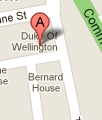Caring for your Teeth
Brushing
Here are a few dental hygiene pointers to keep in mind when going through your daily brushing routine:
- Brush for at least 2 minutes each time to thoroughly clean all tooth surfaces.
- Brush your tongue using a back-to-front sweeping method to remove food particles and freshen your mouth.
- Remember to gently brush the roof of your mouth.
Choosing a Toothpaste
Your toothpaste's taste can make brushing a more enjoyable experience, leading to more thorough brushing, better dental hygiene and reduced risk for gum disease. It is also important to choose a toothpaste that meets your dental health needs. For example, select a toothpaste with fluoride to help strengthen weak spots and help prevent cavities.
For children’s teeth, it is always advisable to choose a toothpaste designed for milk-teeth, or children’s new adult teeth.
The Right Toothbrush
Choosing the right toothbrush can have a profound impact on your dental hygiene. Children need to use a child-size toothbrush, specific to the size and shape of their mouths and hands. Soft bristles with rounded ends provide gentle cleaning of teeth and delicate gum tissue, and they are available in many different designs to make brushing teeth more enjoyable.
For adults, most dental professionals recommend a soft-bristle brush for removing plaque to help fight cavities and help prevent gum disease.
Replacing Your Toothbrush
It is advisable to replace your toothbrush every three months. Some toothbrushes come with a harmless non-toxic dye which gradually wears away during brushing as an indicator to the lifecycle of your toothbrush.
As a rule of thumb, when the bristles on your brush start to look splayed in a fan-like effect when it is dry, replace it.
Nutrition and Dental Health
The bottom line is that a good diet equals healthier teeth. Sugary snacks can lead to cavities. Choose nutritious snacks for you and your family, such as vegetables, low-fat yogurt, fruits and low-fat cheeses, which are healthier and better for your teeth.
Flossing
So why do you need to floss? This necessary part of your daily oral care routine removes plaque and food particles between your teeth, helping to prevent tooth decay.
The Lowdown on Plaque and Tooth Decay
Plaque is a clear, sticky film formed by bacteria in your mouth. If it is not cleaned away, it can irritate your gums, leading to gingivitis, gum disease and eventually tooth decay. Brushing helps remove plaque from the outer surfaces of teeth, but using floss is critical to remove plaque from between your teeth where toothbrushes can't reach.


